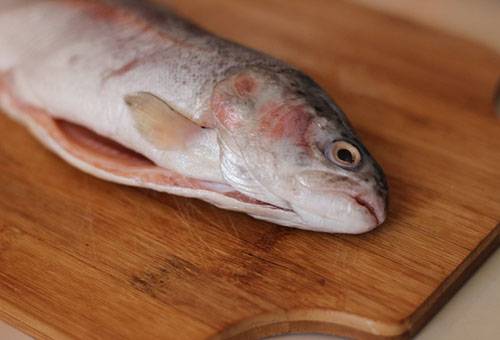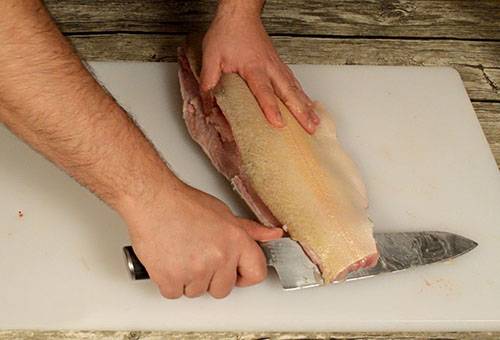Simple rules for trout cleaning and the nuances of cutting it
We are so accustomed to the fish, which is cleaned and cut for us, that when we take our first steps in cooking, we often avoid buying everything that requires additional effort and manipulation. Everything that is not labeled with the word “fillet” is perceived as a product with which you won’t have problems: how to clean trout, sea bass or dorado from scales, gut and rid of bones? Not a fish, but just a chef’s nightmare. But while all these nuances can be true regarding some river fish, trout cleaning is so simple that it will make you return to cooking this fish again and again.
Have you already decided what you want to cook from trout? Then, in the cleaning question, you can focus on key dishes, because for different recipes, the number of preparatory stages can vary.
Roasting the whole carcass
If the fish is small and you want to bake or fry it whole, then we assure you that you can handle cleaning it in just 5 minutes. The thing is that the scales of trout are not like the scales of carp or perch and are very small plates that are peeled off from the fish without the application of great physical effort.
- So, first you need to rinse the fish in running water. If the trout is very slimy and such a carcass is uncomfortable to hold in your hands, then even repeated washing is unlikely to help. It’s better to just sprinkle the fish with salt to create friction: anyway, then it will have to be salted.
- It is best to clean the trout right in the sink: due to the fact that the scales do not stick firmly to the skin, they practically do not scatter around the kitchen, but if something gets on the cabinets, table or floor, then you may just not notice the pollution. The walls of the sink will save you from such trouble, and collecting at the drain will allow you to collect all the large flakes and prevent the water supply from clogging.
- It is convenient to clean the trout with a small knife, both against and in the direction of the scales. Particular care should be taken in the abdomen: the color of the skin there is lighter and the scales are noticeably worse, but at the same time it is harder than on the sides. Slide your finger across the abdomen from head to tail to make sure that the meal will not be spoiled by a crunch on the teeth.
- If the fish is not gutted, it is not so difficult to do it yourself: cut the abdomen from the anal fin to the gill and take out all the insides. If caviar is caught, then you can pickle it, but safely send the rest to the trash.
- You don’t need to cut off your head: just remove the gills so that the dish does not acquire the wrong taste. In addition, the gills, like a filter, do not collect the most useful substances, so it is advisable to remove them if you care about your health.
- Rinse the fish again, and that’s all - you can bake!
Tip
You can not touch the fins and tail: it is not for nothing that in many cafes they are left with fish for the beauty of serving.
If you still clean the fish on the board, then let it be a meat board or a separate fish board. Are you going to take a board for vegetables and bread? We advise you to think about the risk of infection with parasites and at least lay a newspaper.
Fillet, sushi, salad dressing
If you are going to cook a dish in which slices of trout or its fillet are needed, get ready to add a few points to the cutting process. How to clean trout so that it can be added to salad or sushi? You can see all the basic actions above, and here are the manipulations that we will do now.
To get delicious slices, we need to remove the skin from the trout. With small fish, you can remove it with a stocking, having first cut off your head, but for a small fish this action rarely makes sense: getting a thick enough fillet layer from it is very difficult, so this option is not often used.
- If the fish is large, then before you clear it from the skin, you have to cut the carcass. To do this, after cutting off your head, you will need to cut the fish along the back line along the spine. As a result, you will get 2 identical halves, on one of which there will be a ridge.
- The spine with bones will need to be removed, but it is not necessary to throw it away. Most likely, some meat will remain on it, and on the basis of the ridge of a rather large trout, it will be possible to cook soup. The fins are also cut out at this stage.
- Well, the last step is to cut the fillet from the skin. If you have ever made sandwiches with red fish, you can imagine this process: cutting the fillet, you need to cut the meat by pressing the knife to the board so that there are no large pieces left on the skin. The only thing to work with raw trout and remove the fillet in one piece, you have to get a little work out. The key to success will also be a sufficiently strong and long knife: it is desirable that the length of the knife is not shorter than the width of the fillet.
Tip
Start poking the fillet from the tail: since the fillet is shorter there, it is more convenient to start cutting meat in this direction.
It is easy to clean both small and weighty trout if you apply this butcher's manual in practice. We are sure that from now on, when you are going to prepare a dish from her tender meat, you will not delay the culinary experiment due to the unwillingness to mess with cleaning the fish.
We advise you to read: how to clean perch

